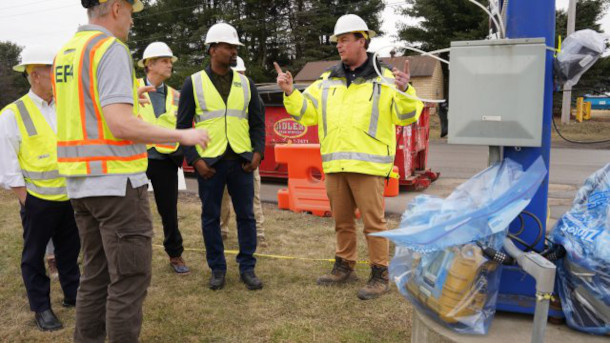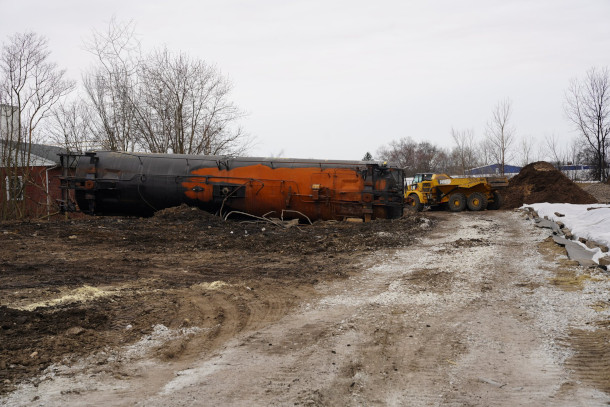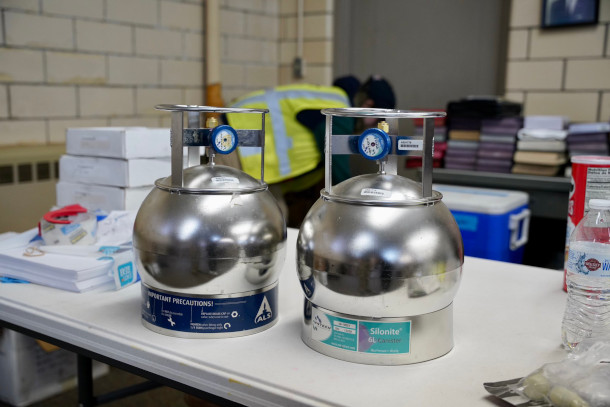Chemical Concerns of the Ohio Train Disaster
Air Date: Week of February 24, 2023

EPA Administrator Michael Regan discusses air monitoring equipment with on-scene coordinators. (Source: U.S. EPA, epa.gov, public domain)
Eleven of the 38 train cars that came off the tracks in East Palestine, Ohio in early February contained hazardous materials including the carcinogen vinyl chloride. Crews intentionally released and burned vinyl chloride to avoid a potential explosion. Ideastream Public Media’s Abigail Bottar joins Host Bobby Bascomb to discuss residents’ lingering concerns about the long-term effects of the chemicals in their community.
Transcript
BASCOMB: From PRX and the Jennifer and Ted Stanley Studios at the University of Massachusetts Boston, this is Living on Earth. I’m Bobby Bascomb.
On Friday, February 3rd a freight train operated by Norfolk Southern derailed in East Palestine, Ohio. Eleven of the 38 train cars that came off the tracks contained hazardous chemicals including vinyl chloride, a colorless gas used to make PVC pipe and classified as a known carcinogen by the EPA. Three days later, amid the fiery wreckage and remnants of the initial disaster, crews intentionally released vinyl chloride into the air to avoid a potential explosion. Local resident Jamie Cozza demanded a full toxicology report, which found it was unsafe for her to return to her home, despite early assurance from local officials that everything was fine.
COZZA: Like I told the toxicologist, he said we haven’t tested the soil yet. Then how do you know it’s safe for me to go home? That’s the problem, no one knows and they just send us back in here no instructions, everything’s back to normal. Go home. We were told go back to your homes it’s safe. My home wasn’t safe, how many other mistakes did they make.
BASCOMB: Abigail Bottar is a reporter with Idea Stream Public Media in Ohio and has been covering the Norfolk Southern train derailment for station WKSU. Welcome to Living on Earth Abigail!
BOTTAR: Hi, thank you for having me.
BASCOMB: What were some of the chemicals involved in this spill? And how dangerous are they?

A train car lies on its side at the scene of the derailment. (Photo: U.S. EPA, public domain)
BOTTAR: Absolutely. So that was a big criticism that people have that the EPA and Norfolk Southern and whatever other agencies did not come up front and say what was on the train. It wasn't until Monday that we knew that it was the vinyl chloride that was the issue. I believe Sunday night–that was when the evacuation was put in place. That was February 5th. There was a list released. The main chemicals were the vinyl chloride and butyl acrylate. Vinyl chloride is a carcinogen and long exposure to it is known to cause cancers. The butyl acrylate can cause irritation and burns to the skin and eyes and can cause headaches, dizziness, nausea, vomiting, and repeated exposure can lead to permanent lung damage. So that's what we knew of by the time the evacuation started. A week later, though, the EPA finally released the full list of the contents of the train, and three more hazardous chemicals were also on the train that the public was not aware of until now. And those chemicals can also cause things like coughing, shortness of breath, dizziness, drowsiness, headaches, nausea and weakness. So those are some of the things on the trains; health officials are reaffirming that those are the side effects. But they say it's unclear what the long-term impact of exposure to these are. And it's kind of unclear, like, what the impact to the air long term will be, to the water, to the soil. So it's unclear what residents may be facing in a decade or two.
BASCOMB: What are they facing right now? What are people saying? Are there symptoms that they're experiencing?
BOTTAR: People are saying they are experiencing headaches, rashes, congestion, that the air is, like, hard to breathe, it's burning their eyes, there's still like, smells, fumes, around town. When I was on the ground last week I did not smell anything. But until today I've still been hearing people saying that it smells really bad. And the scent has been captured in people's homes. I talked to one woman who said they had to buy all new furniture because their furniture just smelled so bad. So there's just this lingering scent around town that people are saying is aggregating their symptoms.
BASCOMB: And yet the governor and, from what I understand, EPA Administrator Regan, have both been to East Palestine, drank the water, showed everybody that it was safe and said, you know, everything's fine, we're monitoring the situation. But that doesn't line up with the lived experience of people that live there. To what degree is there a credibility gap here?
BOTTAR: I think there definitely is. I mean, I think that there is now this lack of trust in these government agencies, both because what they're saying isn't matching up with what people are experiencing and also because they really aren't able to answer the questions that residents actually have, which is: can my kids live here safely? What is the long term impact of this going to be? Are our pets safe? Is the water going to be safe in ten years? These are some questions that, you know, really no one knows the answer to and it's making residents just feel very, like, not able to trust the people who are trying to answer their questions.

Stainless steel canisters used by the EPA to collect and test air samples. (Photo: U.S. EPA, public domain)
BASCOMB: Now, Ohio is a really important agricultural state. How are farmers being impacted, if at all, from the spill?
BOTTAR: Yeah, and especially this area. When I was in East Palestine, I spoke to people that live in the town itself and also people in the surrounding towns and even the surrounding counties. And they told me that a lot of their produce and meats and vegetables come from East Palestine in the Columbiana County. So we really don't know right now what the impacts will be. I have heard reports of farm animals getting sick and dying. But the Ohio Department of Health said that they have not been able to substantiate any of those claims. I think that the Ohio veterinarian, the state veterinarian, had been on the ground and urging people to talk to their vets to document any symptoms their farm animals or pets were having. So it's pretty unclear at this point how agriculture will be impacted. I will say part of the remediation efforts that Norfolk Southern in conjunction with the EPA will be doing is soil testing and sampling and remediating soil and water in the local creek. But at this point, it's pretty unclear, like, long term how this will affect that area.
BASCOMB: And some of these chemicals also reached local waterways and rivers. What's the latest information about how those ecosystems were affected?
BOTTAR: The vinyl chloride and other chemicals did get into the local creek and killed hundreds of fish. I'm sure we've all seen tweets and videos and pictures of dead fish in the water. It was very scary. They are currently remediating that local creek, they've, like, dammed it off on both ends around the spill, and they're rerouting the water around that impacted part. There were some reports of contamination in the Ohio River, but at this point in time, the governor said last week that there's no concern for the Ohio River right now. There's no contamination any longer. And there's just going to be some continued monitoring just to be extra safe. But he said there's no concern there.
BASCOMB: Now, you said at the beginning of our chat here that it took about a week for the EPA to tell people what chemicals were in that train and what they needed to be concerned about. Now, my understanding is that that's kind of standard, that, you know, communities where these trains are rolling through, they don't have access to the information. The train companies aren't obligated to tell people what they're carrying, what hazardous chemicals might be on board. What are you hearing about, you know, potential changes to that rule and how we might avoid this situation in the future?
BOTTAR: Yeah, that's completely correct. From the beginning, I spoke to environmental advocates, and I've also seen rail unions speak out about this. They say, we've been calling for this greater accountability and greater transparency from freight rail companies for years. That communities should know what's rolling through their town on tracks. I mean, I grew up really close to train tracks. A lot of my coworkers did.
Transportation Secretary Pete Buttigieg visited East Palestine, Ohio, to tour the site where a train wrecked nearly three weeks ago as the government faces growing criticism over the federal response to the derailment. https://t.co/apGvvfGTpc
— The Associated Press (@AP) February 23, 2023
BASCOMB: Yeah, me too.
BOTTAR: Lots of people grow up on train tracks. I never thought once, what's on that train? And we should know what's on that train. And I mean, people are saying it's far and few derailments that happen. For the most part, trains are very safe to carry these hazardous materials–they are–that's the safest way to carry hazardous chemicals. But in the instance like this where derailment does occur, communities should be able to make contingency plans, to make public health plans, to make environmental plans. So that's kind of what advocates have been calling for years. And I think this might actually–I've seen a lot of momentum–be the push to make that change happen. So there have been calls. Governor Mike DeWine, our Ohio Senators Sherrod Brown and J.D. Vance, all have called for Congress or the federal government to take up this issue and to put stricter regulations on freight rail companies. That could be like, labeling train cars better so communities know what's on them, upgrading safety systems like brakes, making it so they have to employ more people so they can do better inspections. Some of this stuff would just be reinstating some Obama era rules that were rolled back during the Trump administration. But there is a really big push for Congress to take action. If Congress did it, then it would obviously be more permanent than if the Biden administration made a rule which then a future president could just roll back like we saw this time. So there is a very big push for that to happen from both Democrats and Republicans and lots of talk about working across the aisle to get this legislation passed.
BASCOMB: Abigail Bottar is a reporter for Ideastream Public Media in Ohio. Abigail, thank you so much for your time today.
BOTTAR: You're welcome.
BASCOMB: We reached out to Norfolk Southern for a response. They replied by email with a list of actions they’ve taken including more than 4 million dollars in direct financial assistance, hundreds of in-home air quality monitors and remediation efforts for soil and waterways. To see the full response from Norfolk Southern visit the Living on Earth website, loe.org.
Links
USA Today | “Ohio Train Derailment Fact Check: What's True and What's False?”
Living on Earth wants to hear from you!
Living on Earth
62 Calef Highway, Suite 212
Lee, NH 03861
Telephone: 617-287-4121
E-mail: comments@loe.org
Newsletter [Click here]
Donate to Living on Earth!
Living on Earth is an independent media program and relies entirely on contributions from listeners and institutions supporting public service. Please donate now to preserve an independent environmental voice.
NewsletterLiving on Earth offers a weekly delivery of the show's rundown to your mailbox. Sign up for our newsletter today!
 Sailors For The Sea: Be the change you want to sea.
Sailors For The Sea: Be the change you want to sea.
 The Grantham Foundation for the Protection of the Environment: Committed to protecting and improving the health of the global environment.
The Grantham Foundation for the Protection of the Environment: Committed to protecting and improving the health of the global environment.
 Contribute to Living on Earth and receive, as our gift to you, an archival print of one of Mark Seth Lender's extraordinary wildlife photographs. Follow the link to see Mark's current collection of photographs.
Contribute to Living on Earth and receive, as our gift to you, an archival print of one of Mark Seth Lender's extraordinary wildlife photographs. Follow the link to see Mark's current collection of photographs.
 Buy a signed copy of Mark Seth Lender's book Smeagull the Seagull & support Living on Earth
Buy a signed copy of Mark Seth Lender's book Smeagull the Seagull & support Living on Earth

